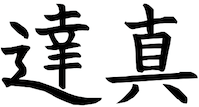Algorithms may not be something you would normally associate with meditation, but they are an extremely powerful way to understand meditation.
An algorithm is a concept that comes from math, science, and technology. It is a series of steps used to solve a specific problem – not the problem itself, but the way you solve the problem. Here’s a simple algorithm:
- If hungry, eat food;
- If not hungry, don’t eat food;
- Repeat.
In this series, I will explain how meditation relates to algorithms, and share a few practical examples. I will rely heavily on the teachings of two meditation teachers, Shinzen Young and Soryu Forall. This understanding will help you to deepen your meditation practice, and may also make it more fun. I will also venture into speculative, futuristic territory that will address the opportunities and threats of the connection between meditation and algorithms.
How does meditation relate to algorithms?
The meditation teacher Shinzen Young is famous in the meditation world for bringing meditation to science and science to meditators. It’s fitting, then, that he has adopted algorithms as a basic metaphor for his teachings:
I often describe my approach to meditation as ‘algorithmic’ meaning that I take people through a sequence of procedures that loops and branches depending on what’s coming up for them…thereby optimizing their chances of having a productive experience.
– Shinzen Young, Algorithm and Emptiness
In the above description of algorithmic meditation, Shinzen uses four key ideas: sequences, branching, looping, and optimizing.

In a sequence, there are a number of steps to take, and they should be taken in order.
Branching means that there are multiple, exclusive options. If I am hungry, I will eat; if I am not hungry, I will not eat. The key variable is “Am I hungry?”
Looping means that you follow a branch until it is done, and start over at the same branch or a different branch as needed. For example, if you eat, you will not be hungry for a time, so you will not eat, but eventually you will be hungry again, and you will need to eat again.
Optimizing means that some solutions are better than others. If you are hungry, it is better to eat than not to eat.
Following the breath is one of the simplest and most frequently taught meditation techniques. This is the technique I used when I started meditating in college. Each day, I would find time to sit for fifteen or twenty minutes. I would sit in a chair in my dorm room and try to follow my breath.
This was very hard at first. I was astonished by how hard it could be to do something so simple. It made me angry – “Why can’t I do this?”
I soon learned that getting angry at myself didn’t help. Later, I would learn that the opposite approach would help – being gentle and kind to myself, and even feeling grateful when I noticed I was distracted. Learning that lesson took more time, though.

Let’s parse this technique as an algorithm. Here are the instructions:
- Select a focus space related to your physical sensations associated with breathing: breathing at the abdomen; breathing at your nostrils; all sensations associated with breathing, etc.
- Bring attention to that focus space, in the foreground of your conscious experience. Continue to maintain awareness of the rest of your experience, including the rest of your body, the room you are in, and your mental state, in the background of your conscious experience.
- If you stay with the breath, continue the technique, bringing increased mindfulness to the focus space.
- If you get distracted, gently acknowledge that you have been distracted, with kindness to yourself, and gratitude towards your awareness for letting you notice your distraction. Return to step two.
The four steps are the sequence. The variable of concentration or distraction determines the technique’s branches, although both result in looping back to step two. This should result in increased and optimized mindful awareness.
